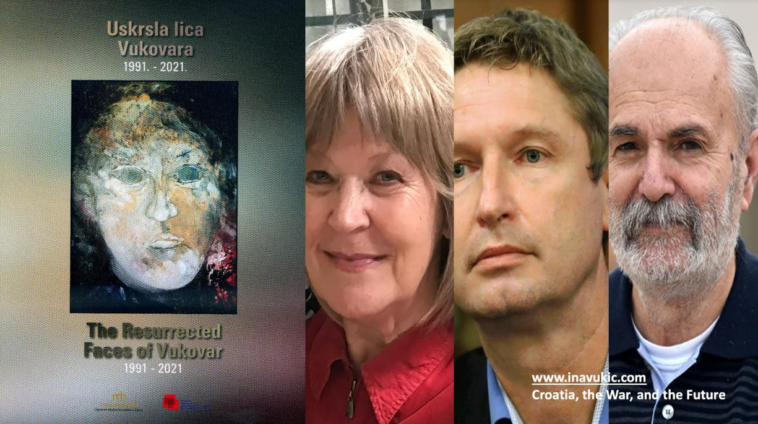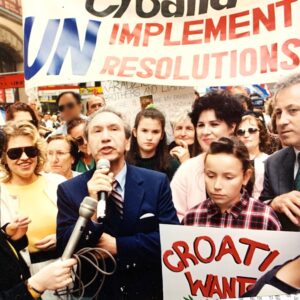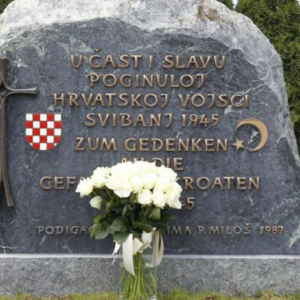Understanding the reasons for and extent of the evil that Greater Serbia committed against the heroic Croatian city of Vukovar and the whole of Croatia constant reminders, credible corroboration, hermeneutical reading, and artistic interpretation of historical facts are required for the sake of the truth.
„Resurrected Faces of Vukovar 1991 – 2021“, published by Croatian Homeland War Memorial Centre (headed by dr. sc. Ante Nazor) and Matica Hrvatska -Zadar (headed by dr. sc. Radomir Juric) in December 2021, presents unequivocally a book of remembrance and honour to the victims of Serb aggression. Furthermore, the ethnic cleansing of Croats and wanton destruction of Croatia’s Vukovar during and after its siege from 1991 referred to in this book come alive in our minds once more, nudging us to try and understand that which is often impossible to understand because of the aggressor’s depraved cruelty involved. It was published to mark the 30th anniversary of the Vukovar tragedy that culminated horribly in November of 1991. The book was compiled and edited by the well-known author and Croatian freedom activist Julienne Busic and is presented in a bi-lingual edition, Croatian and English. Julienne Busic also wrote the foreword for the book and several of the texts. The book is a wealth of series of texts, illustrations, pictorial presentations, documentary material, created or arose during the period and resulting from the Serb and Yugoslav People’s Army aggression and Croatia’s Homeland War of 1990’s. All material presented relates to actual events that occurred during the years of the Homeland War in the city of Vukovar.
“Resurrected Faces of Vukovar 1991 – 2021” with its contents is an overwhelming reminder of the cruelty Croatian victims either suffered, endured and/or survived because of Serb and Yugoslav People’s Army aggression. The great value of this book is not merely in its exceptionally well-chosen variety of evidentiary material of suffering in Vukovar but also in its psychological significance for the understanding of what had occurred in that depravity of Serb aggression; the aggression that saw repeated and incessant tragedies of brutal death, brutal rape, brutal torture, brutal destruction every day and every night for over three months in 1991 and afterwards in concentration camps. It is said that we must repeat seeing things that occurred those thirty years ago in Vukovar, to corroborate and verify repeatedly to understand them towards perhaps easing the deep pain that the memory of them still brings.
The renowned and widely respected journalist, a native to the city of Vukovar, Tihomir Vinkovic, knowing that many a reader who has known the horrendous suffering of Croats in Vukovar during Croatia’s Homeland War would approach reading this book with expectations of poignance, sorrow directed at the victims and even profound bitterness and anger directed at the Serb aggressor, introduces us skilfully to the historic Vukovar, both in its grandeur and its suffering. His text is followed by parts of the poem “Vukovar” by the Croatian artist and writer Tomislav Marijan Bilosnic entitled “Who are those who go against tanks”.
“The life of the dead is placed in the memory of the living” section of this book is a rich collage of various government communiques, newspaper excerpts (domestic and foreign), statements regarding suffering in Vukovar by those key personalities and leaders at the time, who were tasked with verifying the existence of many mass graves and exhumed, tortured human remains of the genocide Serbs perpetrated with the assistance of the Yugoslav People’s Army in Vukovar. Accounts of Croats that are still missing, of raped women, of maimed civilians and soldiers, of the ethnically cleansed and forcefully banished from their homes – all of whom had lived through the nightmare that Vukovar was. These excerpts and records of historical facts of Vukovar 1991-1995 are a harrowing indictment against the Serbs and pro-communist Yugoslavia aggressors that Croats must never forget as Lord David Owen, the book quotes, said in February 1996 “Vukovar remains on the conscience of the world”.
The reader is then presented with the academic paper by Sanja Knezevic PhD, presented at the Eighth Regional Conference of the European Association of Women in Theological Research 2012 in Split, Croatia. This academic paper titled and subtitled “The Suffering and Resurrection of Raped Vukovar Detainees 1991 –1992: Does Postmodern Culture Tolerate Suffering? The abstract of this academic paper reads as follows: “The perception of women’s suffering in contemporary society is analyzed, based on the statements of the abused and raped Vukovar women, which were recorded and made public in the book, Sunny (2011). The Vukovar story, which can be regarded as a prototype of women’s suffering and grief in all wars, shows that rape, the most serious crime against humanity and its divine image in 21st century society, still has no place in our consciousness.
In addition to not receiving any kind of civil rights in the sense of compensation for the pain they suffered, they also have not been offered psychological assistance or support. The perpetrators of the crimes against them have for the most part not been tried; society has not reacted to the seriousness of their crimes. Women who have endured rape and torture live with permanent repercussions, but they live.”
This thorough and confronting presentation of discussion and facts surrounding the suffering of Vukovar women and other detainees are a stark and sad reminder of how attitudes vary towards depravity of genocide and mass torture should only have one attitude and that attitudes encompasses intolerance with all its aspects.
There’s a very useful and clear Brief Review of the Disintegration of Yugoslavia and the Battle of Vukovar written by one of Croatia’s leading historians Ante Nazor and the propeller that drives the practice and notion of remembering what occurred and how much suffering was endured by the Croatian people as a result of Serb and Yugoslav People’s Army aggression and utter brutality.
Otherwise, dr Ante Nazor, director of the Croatian Homeland War Memorial and Documentation Centre said this about the book:
“This is a collection of works on Vukovar, from art to history, and what is very important to emphasise are parts of books that have already been published somewhere, some are not, but it is important to emphasise that everything is translated into English and thus available to the foreign public to try to understand what was happening in Vukovar. We owe special gratitude to Julienne Busic, this is a person who considers Croatia her homeland, and with her actions before and now with this book she shows how much she cares about Croatia, so that the period of the Homeland War is not forgotten ”
There is a moving excerpt, from Julienne Busic’s, “2013 A.B. Simic” award-winning novel Živa glava / Living Cells that was inspired by the testimony of a young Croatian woman who was sexually and serially abused at the beginning of the Serb aggression against Vukovar and occupation of Vukovar for the purposes of creating Greater Serbia.
Julienne Busic said in January 2022, when this book was launched in Zadar Croatia: “I have a special connection with Vukovar, I worked on the excavation of the mass graves in Vukovar, and I saw everything and wrote reports and took photographs for reports for the outside world in English, and it must not be forgotten, it must be recorded for future generations.”
An excerpt, the chapter on War in Vukovar, from the book “Vukovar Hospital: a lighthouse in the historical storms of Eastern Croatia” by historian Ivo Lucic, 2017, is a shocking reminder of the Serb and Yugoslav People’s Army unthinkable cruelty Croatians were faced with and many perished under as the aggression ensued and progressed.
In this chapter dr.sc. Ivo Lucic aptly reminds the reader of how the tragedy of aggression against Croatia started: “The most important political decision the Croatian government made was to pass in Parliament, on June 25, 1991, the „Constitutional Declaration on the Sovereignty and Independence of the Republic of Croatia“ on the basis of results of a referendum held on May 19, 1991. In agreement with representatives of the European Community, the implementation of this proclamation was postponed for three months to resolve the crisis in a peaceful manner.
However, instead of peace, a fierce attack was launched on the institutions of the Republic of Croatia, its statehood and sovereignty, which caused immense human suffering and significant material damage. A civil conflict of sorts in Croatia quickly escalated into outright aggression by Serbian-Yugoslav military formations in Croatia. The Croatian Parliament passed the ‘Decision on
the termination of Croatia’s legal relations with the SFRY’ on October 8 and the ‘Resolution regarding aggression against the Republic of Croatia’, which reinforced the initial declaration. This was the day after the Yugoslav People’s Army air force attacked Banski Dvori in an attempt by the Yugoslav Army leadership to kill the President of the Republic of Croatia and his closest associates and stop the country’s path to independence.”
The book offers the reader a very touching excerpt from the book: “We Defended our Homeland: national minorities in the defense of Croatia”, authors Ivica Radoš and Zoran Šangut, 2013 which tells the reader Nenad Gagic’s story, the story of the son of a Serbian Orthodox priest from Pacetin, Croatia, who volunteered into the Croatian volunteer defence forces because somebody was attacking “his homeland!”.
The reader is presented in the book with letters written by world leaders to the President of Croatia, Franjo Tudjman, including a letter from UK Prime Minister Margaret Thatcher, January 9, 1998, in which she concluded with these words: “As you begin the difficult and delicate process of restoring human rights, order and prosperity to Croatia’s recovered territory, you can take heart that a just cause has triumphed, and that those who gave their lives for it did not die in vain.”
The book concludes with a series of moving reproductions of paintings and statements by Austrian artist Hermann Pedit (1933 – 2014) who was present at the Vukovar exhumation of victims in 1998 and then, at his “Night of the Soul” exhibition at the Mimara Museum, which opened on September 16, 1999 with a meticulous review, Dark Body, by Academic Tonko Maroevic, presented his opus dedicated to the Serbian war victims.
“Resurrected Faces of Vukovar 1991 – 2021” is not only a book of brief and yet all-encompassing record of insufferable cruelty against Croats in Vukovar at the hands of Serb and Yugoslav People’s Army aggressors but it is also a book that channels those victims into the field of resurrections, of live presence in our lives today, so that we may assist in lasting remembrance of this painful heritage of Croatia, which brought Croatia’s independence and freedom despite the cruelty.
Ina Vukic,
Sydney, 9th April 2022
While the Kindle version of the book is expected soon the book itself may be purchased via contacting Croatian Homeland War Memorial Centre
Email: centar@centardomovinskograta.hr




